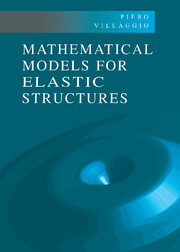Book contents
- Frontmatter
- Contents
- Preface
- Introduction
- Chapter I Basic Concepts
- Chapter II Rod Theories: Three-dimensional Approach
- Chapter III Rod Theories: Director Approach
- Chapter IV Theories of Cables
- Chapter V Theories of Membranes
- Chapter VI Theories of Plates
- Chapter VII Theories of Shells
- References
- Index of Authors Cited
- Index
Chapter VI - Theories of Plates
Published online by Cambridge University Press: 11 September 2009
- Frontmatter
- Contents
- Preface
- Introduction
- Chapter I Basic Concepts
- Chapter II Rod Theories: Three-dimensional Approach
- Chapter III Rod Theories: Director Approach
- Chapter IV Theories of Cables
- Chapter V Theories of Membranes
- Chapter VI Theories of Plates
- Chapter VII Theories of Shells
- References
- Index of Authors Cited
- Index
Summary
The Equations of Linear Theory
A planar plate, like a planar membrane, is a solid layer bounded by two parallel planes and by a cylinder that intercepts the planes at right angles. The plane midway between the faces is called the “middle plane.” We can draw any cylindrical surface to cut the middle plane in a curve s. The particular cylinder that coincides with the lateral surface of the plate is called the “edge.” We choose rectangular axes x and y placed in the middle plane and draw the z axis at right angles to this plane, so that the upper and lower plane faces have the equations z = h and z = —h, respectively, where 2h represents the thickness of the plate. We draw the outer normal v to s, lying in the middle plane, the unit vector s tangentially to s, and the unit vector n normal to the middle plane (Love 1927, Art. 296). These three unit vectors are oriented such that they form a right-handed orthonormal basis (v, s, n).
Let δs be an arc element of the curve s, and let us suppose that the generators of, drawn through the extremities of δs, mark out on a piece of cylindrical surface of base δs and height 2h, called the area of this element δA. The tractions across the area δA are statically equivalent to a force applied at the centroid of δA together with a couple. We resolve, as we did for membranes, this force into three components 8T, δS, and δN directed along v, s, and n, respectively, and resolve the couple into three components δH, δG, and δK directed along the same vectors. We then take the limits of the ratios δT/δs,…, δK/δs as δs tends to zero. We postulate that the limit of δK/δs is zero, but all other limits are finite The limits of δT/δs, δS/δs, and 8N/ds are denoted by T S, and N, respectively, and those of SH/δs, and δG/δs by H and G. T is a tension, S and N are shearing forces tangential and normal to the middle plane, G is a bending couple, and H is a torsional couple.
- Type
- Chapter
- Information
- Mathematical Models for Elastic Structures , pp. 451 - 546Publisher: Cambridge University PressPrint publication year: 1997



